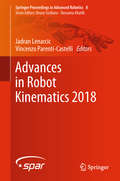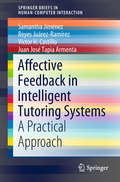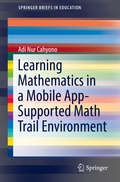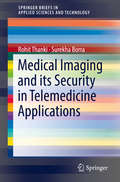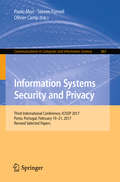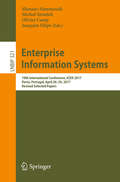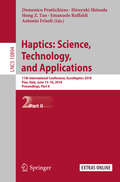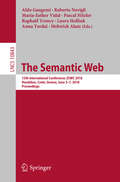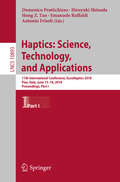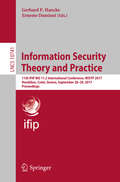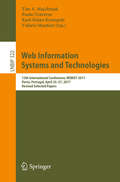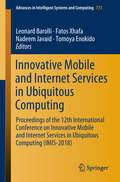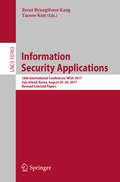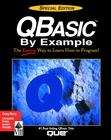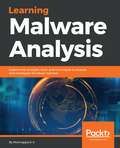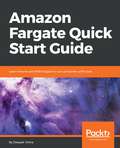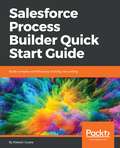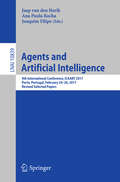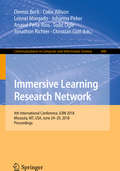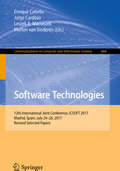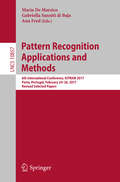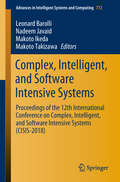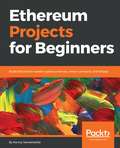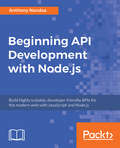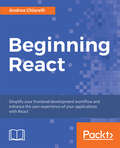- Table View
- List View
Advances in Robot Kinematics 2018 (Springer Proceedings in Advanced Robotics #8)
by Jadran Lenarcic Vincenzo Parenti-CastelliThis is the proceedings of ARK 2018, the 16th International Symposium on Advances in Robot Kinematics, that was organized by the Group of Robotics, Automation and Biomechanics (GRAB) from the University of Bologna, Italy.ARK are international symposia of the highest level organized every two years since 1988. ARK provides a forum for researchers working in robot kinematics and stimulates new directions of research by forging links between robot kinematics and other areas.The main topics of the symposium of 2018 were: kinematic analysis of robots, robot modeling and simulation, kinematic design of robots, kinematics in robot control, theories and methods in kinematics, singularity analysis, kinematic problems in parallel robots, redundant robots, cable robots, over-constrained linkages, kinematics in biological systems, humanoid robots and humanoid subsystems.
Affective Feedback in Intelligent Tutoring Systems: A Practical Approach (Human–Computer Interaction Series)
by Samantha Jiménez Reyes Juárez-Ramírez Victor H. Castillo Juan José Tapia ArmentaAffective components are as important as cognitive components in tutoring assisted learning process. Feedback from tutors is essential in keeping students motivated. Affectivity and motivation are also significant in computer-based tutoring systems. However, several educational frameworks do not include this kind of interaction between students and tutoring systems. In those cases, the students learning interest and motivation to learn could be negatively affected, and student profits from the system could be impoverished. This is why tutoring systems need to provide direct and affective interaction with students; it can encourage them and increase the motivation to learn. This book introduces a broad range of topics in affective learning in computer-based systems. The text offers a deep conceptual background, covering relevant concepts of affectivity, feedback and motivational components in learning environments. It describes the design of a proposed model for providing affective feedback, the mathematical validation of the conceptual model and its implementation. Moreover, it presents an analysis of the impact of the affective feedback on student motivation to learn. Finally, the book offers research perspectives of the impact and applicability of the affective feedback in computer-based tutoring environments. Affective Feedback in Intelligent Tutoring Systems can be used by human tutors who want to include motivational and affective elements in the learning process, researchers in Human-Computer Interaction and Education and by software developers who want to develop learning systems using these elements.
Learning Mathematics in a Mobile App-Supported Math Trail Environment (SpringerBriefs in Education)
by Adi Nur CahyonoThis brief presents the results of a study on the development of the mobile app-supported math trail program for learning mathematics. This study is a part of the MathCityMap-Project, a project of the MATIS I Team from IDMI Goethe-Universität Frankfurt, Germany, that comprises math trails around the city that are supported by the use of GPS-enabled mobile phone technology. The project offers an activity that is designed to support students in constructing their own mathematical knowledge by solving the prepared mathematical tasks on the math trail and interacting with the environment, including the digital environment. The brief focuses specifically on the development of a model for a mobile app-supported math trail programme and the implementation of this programme in Indonesia. It offers both an empirical exploration of its implementation as well as critical assessment of students’ motivation in mathematics, their own performance, as well as teachers’ mathematics beliefs. It concludes with a future-forward perspective by recommending strategies for implementation in schools, among the general public of the existing math trails (including its supporting tool). It also discusses strategies for developing and designing new trails and suggests further research in other geographical regions and contexts for continued project development and implementation. Learning Mathematics in a Mobile App-Supported Math Trail Environment articulates an innovative and exciting future for integrating real mathematical tasks and geographic and digital environment into effective mathematics education.
Medical Imaging and its Security in Telemedicine Applications (SpringerBriefs in Applied Sciences and Technology)
by Rohit Thanki Surekha BorraThis book introduces medical imaging, its security requirements, and various security mechanisms using data hiding approaches. The book in particular provides medical data hiding techniques using various advanced image transforms and encryption methods. The book focuses on two types of data hiding techniques: steganography and watermarking for medical images. The authors show how these techniques are used for security and integrity verification of medical images and designed for various types of medical images such as grayscale image and color image. The implementation of techniques are done using discrete cosine transform (DCT), discrete wavelet transform (DWT), singular value decomposition (SVD), redundant DWT (RDWT), fast discrete curvelet transform (FDCuT), finite ridgelet transform (FRT) and non-subsampled contourlet transform (NSCT). The results of these techniques are also demonstrated after description of each technique. Finally, some future research directions are provided for security of medical images in telemedicine application.
Information Systems Security and Privacy: Third International Conference, ICISSP 2017, Porto, Portugal, February 19-21, 2017, Revised Selected Papers (Communications in Computer and Information Science #867)
by Paolo Mori Steven Furnell Olivier CampThis book constitutes the revised selected papers of the Third International Conference on Information Systems Security and Privacy, ICISSP 2017, held in Porto, Portugal, in February 2017. The 13 full papers presented were carefully reviewed and selected from a total of 100 submissions. They are dealing with topics such as vulnerability analysis and countermeasures, attack patterns discovery and intrusion detection, malware classification and detection, cryptography applications, data privacy and anonymization, security policy analysis, enhanced access control, and socio-technical aspects of security.
Enterprise Information Systems: 19th International Conference, ICEIS 2017, Porto, Portugal, April 26-29, 2017, Revised Selected Papers (Lecture Notes in Business Information Processing #321)
by Slimane Hammoudi Michał Śmiałek Olivier Camp Joaquim FilipeThis book constitutes extended and revised papers from the 19th International Conference on Enterprise Information Systems, ICEIS 2017, held in Porto, Portugal, in April 2017. The 28 papers presented in this volume were carefully reviewed and selected for inclusion in this book from a total of 318 submissions. They were organized in topical sections named: databases and information systems integration; artificial intelligence and decision support systems; information systems analysis and specification; software agents and internet computing; human-computer interaction; and enterprise architecture.
Haptics: 11th International Conference, EuroHaptics 2018, Pisa, Italy, June 13-16, 2018, Proceedings, Part II (Lecture Notes in Computer Science #10894)
by Domenico Prattichizzo Hiroyuki Shinoda Hong Z. Tan Emanuele Ruffaldi Antonio FrisoliThe two-volume set LNCS 10893 and 10894 constitutes the refereed proceedings of the 11th International Conference EuroHaptics 2018, held in Pisa, Italy, in June 2018. The 95 papers (40 oral presentations and 554 poster presentations) presented were carefully reviewed and selected from 138 submissions. These proceedings reflect the multidisciplinary nature of EuroHaptics and cover all aspects of haptics, including neuroscience, psychophysics, perception, engineering, computing, interaction, virtual reality and arts.
The Semantic Web: 15th International Conference, ESWC 2018, Heraklion, Crete, Greece, June 3–7, 2018, Proceedings (Lecture Notes in Computer Science #10843)
by Aldo Gangemi Roberto Navigli Maria-Esther Vidal Pascal Hitzler Raphaël Troncy Laura Hollink Anna Tordai Mehwish AlamThis book constitutes the refereed proceedings of the 15th International Semantic Web Conference, ESWC 2018, held in Heraklion, Crete, Greece.The 48 revised full papers presented were carefully reviewed and selected from 179 submissions. The papers cover a large range of topics such as logical modelling and reasoning, natural language processing, databases and data storage and access, machine learning, distributed systems, information retrieval and data mining, social networks, and Web science and Web engineering.
Haptics: 11th International Conference, EuroHaptics 2018, Pisa, Italy, June 13-16, 2018, Proceedings, Part I (Lecture Notes in Computer Science #10893)
by Domenico Prattichizzo Hiroyuki Shinoda Hong Z. Tan Emanuele Ruffaldi Antonio FrisoliThe two-volume set LNCS 10893 and 10894 constitutes the refereed proceedings of the 11th International Conference EuroHaptics 2018, held in Pisa, Italy, in June 2018. The 95 papers (40 oral presentations and554 poster presentations) presented were carefully reviewed and selected from 138 submissions. These proceedings reflect the multidisciplinary nature of EuroHaptics and cover all aspects of haptics, including neuroscience, psychophysics, perception, engineering, computing, interaction, virtual reality and arts.
Information Security Theory and Practice: 11th IFIP WG 11.2 International Conference, WISTP 2017, Heraklion, Crete, Greece, September 28–29, 2017, Proceedings (Lecture Notes in Computer Science #10741)
by Gerhard P. Hancke Ernesto DamianiThis volume constitutes the refereed proceedings of the 11th IFIP WG 11.2 International Conference on Information Security Theory and Practices, WISTP 2017, held in Heraklion, Crete, Greece, in September 2017. The 8 revised full papers and 4 short papers presented were carefully reviewed and selected from 35 submissions. The papers are organized in the following topical sections: security in emerging systems; security of data; trusted execution; defenses and evaluation; and protocols and algorithms.
Web Information Systems and Technologies: 13th International Conference, WEBIST 2017, Porto, Portugal, April 25–27, 2017, Revised Selected Papers (Lecture Notes in Business Information Processing #322)
by Tim A. Majchrzak Paolo Traverso Karl-Heinz Krempels Valérie MonfortThis book constitutes revised selected papers from the 13th International Conference on Web Information Systems and Technologies, WEBIST 2017, held in Porto, Portugal, in April 2017. The purpose of the WEBIST series of conferences is to bring together researches, engineers and practitioners interested in technological advances and business applications of web-based information systems. The 12 full papers presented in this volume were carefully reviewed and selected from originally 77 paper submissions. They contribute to the understanding of relevant trends of current research on Web information systems and technologies, comprising unified interfaces, Progressive Web Apps (PWAs) as well as a mobile device taxonomy, XML and open data processing, the history of Web engineering, web development for end-users, access control, Web platform assessment, rule engines, and scientific blogging.
Innovative Mobile and Internet Services in Ubiquitous Computing: Proceedings of the 12th International Conference on Innovative Mobile and Internet Services in Ubiquitous Computing (IMIS-2018) (Advances in Intelligent Systems and Computing #773)
by Leonard Barolli Fatos Xhafa Nadeem Javaid Tomoya EnokidoThis book presents the latest research findings, methods and development techniques related to Ubiquitous and Pervasive Computing (UPC) as well as challenges and solutions from both theoretical and practical perspectives with an emphasis on innovative, mobile and internet services.With the proliferation of wireless technologies and electronic devices, there is a rapidly growing interest in Ubiquitous and Pervasive Computing (UPC). UPC makes it possible to create a human-oriented computing environment where computer chips are embedded in everyday objects and interact with physical world. It also allows users to be online even while moving around, providing them with almost permanent access to their preferred services. Along with a great potential to revolutionize our lives, UPC also poses new research challenges.
Information Security Applications: 18th International Conference, WISA 2017, Jeju Island, Korea, August 24-26, 2017, Revised Selected Papers (Lecture Notes in Computer Science #10763)
by Brent ByungHoon Kang Taesoo KimThis book constitutes the thoroughly refereed post-conference proceedings of the 18th International Conference on Information Security Applications, WISA 2017, held on Jeju Island, Korea, in August 2017.The 12 revised full papers and 15 short papers presented in this volume were carefully reviewed and selected from 53 submissions. The papers are organized in topical sections such as attack and defense; theory in security; web security and emerging technologies; systems security and authentication; crypto protocols; and attack detections and legal aspects.
Qbasic by Example (Special Edition)
by Greg M. Perry Que Publishing StaffThis book began in 1978, when I first turned on a computer and opened a BASIC manual to page 1, having never touched a computer before. Since then, I have continued to learn and teach BASIC. From that first Microsoft BASIC language, I taught many others, but Microsoft's variants of BASIC continue to be my favorites and old standbys. I am glad that Mr. Gates and his crew at Microsoft continue to support this language; it looks as though they are dedicated, more than ever, to keeping the BASIC flame alive with QBasic.
Learning Malware Analysis: Explore the concepts, tools, and techniques to analyze and investigate Windows malware
by Monnappa K AUnderstand malware analysis and its practical implementationKey FeaturesExplore the key concepts of malware analysis and memory forensics using real-world examplesLearn the art of detecting, analyzing, and investigating malware threatsUnderstand adversary tactics and techniquesBook DescriptionMalware analysis and memory forensics are powerful analysis and investigation techniques used in reverse engineering, digital forensics, and incident response. With adversaries becoming sophisticated and carrying out advanced malware attacks on critical infrastructures, data centers, and private and public organizations, detecting, responding to, and investigating such intrusions is critical to information security professionals. Malware analysis and memory forensics have become must-have skills to fight advanced malware, targeted attacks, and security breaches.This book teaches you the concepts, techniques, and tools to understand the behavior and characteristics of malware through malware analysis. It also teaches you techniques to investigate and hunt malware using memory forensics. This book introduces you to the basics of malware analysis, and then gradually progresses into the more advanced concepts of code analysis and memory forensics. It uses real-world malware samples, infected memory images, and visual diagrams to help you gain a better understanding of the subject and to equip you with the skills required to analyze, investigate, and respond to malware-related incidents.What you will learnCreate a safe and isolated lab environment for malware analysisExtract the metadata associated with malwareDetermine malware's interaction with the systemPerform code analysis using IDA Pro and x64dbgReverse-engineer various malware functionalitiesReverse engineer and decode common encoding/encryption algorithmsPerform different code injection and hooking techniquesInvestigate and hunt malware using memory forensicsWho this book is forThis book is for incident responders, cyber-security investigators, system administrators, malware analyst, forensic practitioners, student, or curious security professionals interested in learning malware analysis and memory forensics. Knowledge of programming languages such as C and Python is helpful but is not mandatory. If you have written few lines of code and have a basic understanding of programming concepts, you’ll be able to get most out of this book.
Amazon Fargate Quick Start Guide: Learn how to use AWS Fargate to run containers with ease
by Deepak VohraThis book gets you started and gives you knowledge about AWS Fargate in order to successfully incorporate it in your ECS container application.Key FeaturesGives you a quick walk-through over the Amazon Elastic Container Services (ECS)Provides an in depth knowledge of the components that Amazon Fargate has to offer. Learn the practical aspects of Docker application development with a managed serviceBook DescriptionAmazon Fargate is new launch type for the Amazon Elastic Container Service (ECS). ECS is an AWS service for Docker container orchestration. Docker is the de facto containerization framework and has revolutionized packaging and deployment of software. The introduction of Fargate has made the ECS platform serverless.The book takes you through how Amazon Fargate runs ECS services composed of tasks and Docker containers and exposes the containers to the user. Fargate has simplified the ECS platform. We will learn how Fargate creates an Elastic Network Interface (ENI) for each task and how auto scaling can be enabled for ECS tasks. You will also learn about using an IAM policy to download Docker images and send logs to CloudWatch. Finally, by the end of this book, you will have learned about how to use ECS CLI to create an ECS cluster and deploy tasks with Docker Compose. What you will learnRunning Docker containers with a managed serviceUse Amazon ECS in Fargate launch modeConfigure CloudWatch Logging with FargateUse an IAM Role with FargateUnderstand how ECS CLI is used with FargateLearn how to use an Application Load Balancer with FargateLearn about Auto Scaling with FargateWho this book is forThis book is for Docker users and developers who want to learn about the Fargate platform. Typical job roles for which the book is suitable are DevOps Architect, Docker Engineer, and AWS Cloud Engineer. Prior knowledge of AWS and ECS is helpful but not mandatory.
Salesforce Process Builder Quick Start Guide: Build complex workflows by clicking, not coding
by Rakesh GuptaClick your way to automating business processes with Salesforce Visual WorkflowKey FeaturesCreate and maintain complex business processes using Process builderDiscover how to debug and deploy Flow and Process BuilderUse new or existing Flows to work with Salesforce Lightning ExperienceBook DescriptionSalesforce Management System is an information system used in CRM to automate business processes, such as sales and marketing. Process Builder is a visual tool created to automate business processes in Salesforce. It enables users with no coding expertise to build complex Salesforce workflows.The book starts with an introduction to Process Builder, focussing on the building blocks of creating Processes. Then you will learn about different applications of Process Builder for developing streamlined solutions. You will learn how to easily automate business processes and tackle complex business scenarios using Processes. The book explains the workings of the Process Builder so that you can create reusable processes. It also explains how you can migrate existing Workflow Rules to Process Builder.By the end of the book, you will have a clear understanding of how to use Flows and Process Builder to optimize code usage.What you will learnDevelop an application using point and click with the help of Process BuilderBypass Processes for specific usersUnderstand the concepts of reusable processesHandle complex business processes using Process Builder and keep them cleanWork with formulae in Process Builder to minimize the code requiredCreate a process with no criteria so as to minimize the amount of reworkOvercome Salesforce's known limitation in terms of referencing picklist valuesWho this book is forThis book is for people who want to use Process Builder to automate their business requirements by clicking, not coding. A basic understanding of Salesforce is required, but not extensive programming knowledge.
Agents and Artificial Intelligence: 9th International Conference, ICAART 2017, Porto, Portugal, February 24–26, 2017, Revised Selected Papers (Lecture Notes in Computer Science #10839)
by Jaap van den Herik Ana Paula Rocha Joaquim FilipeThis book contains the revised and extended versions of selected papers from the 9th International Conference, ICAART 2017, held in Porto, Portugal, in February 24-26, 2017.The 11 full papers were carefully reviewed and selected from 158 initial submissions. The papers are organized in two tracks. The first focuses on agents, multi-agent systems, software platforms, distributed problem solving and distributed AI in general. The second track focuses mainly on artificial intelligence, knowledge representation, planning, learning, scheduling, perception, reactive AI systems, evolutionary computing, and other topics related to intelligent systems and computer intelligence.
Immersive Learning Research Network: 4th International Conference, iLRN 2018, Missoula, MT, USA, June 24-29, 2018, Proceedings (Communications in Computer and Information Science #840)
by Dennis Beck Colin Allison Leonel Morgado Johanna Pirker Anasol Peña-Rios Todd Ogle Jonathon Richter Christian GütlThis volume constitutes the refereed proceedings of the 4th International Conference of the Immersive Learning Network, iLRN 2018, held in Missoula, MT, USA, in June 2018. The 12 revised full papers and the two revised short papers presented in this volume were carefully reviewed and selected from 57 submissions. The papers are organized in topical sections on environmental sciences, climate change, immersive technologies; immersive technologies in cultural heritage; immersive technologies in primary and secondary education; games and game design.
Software Technologies: 12th International Joint Conference, ICSOFT 2017, Madrid, Spain, July 24–26, 2017, Revised Selected Papers (Communications in Computer and Information Science #868)
by Enrique Cabello Jorge Cardoso Leszek A. Maciaszek Marten Van SinderenThis book constitutes the thoroughly refereed post-conference proceedings of the 12th International Joint Conference on Software Technologies, ICSOFT 2017, held in Madrid, Spain, in July 2017. The 17 revised full papers and 24 short papers presented were carefully reviewed and selected from 85 submissions. The topics covered in the papers include: software quality and metrics; software testing and maintenance; development methods and models; systems security; dynamic software updates; systems integration; business process modelling; intelligent problem solving; multi-agent systems; and solutions involving big data, the Internet of Things and business intelligence.
Pattern Recognition Applications and Methods: 6th International Conference, ICPRAM 2017, Porto, Portugal, February 24–26, 2017, Revised Selected Papers (Lecture Notes in Computer Science #10857)
by Maria De Marsico Gabriella Sanniti di Baja Ana FredThis book contains revised and extended versions of selected papers from the 6th International Conference on Pattern Recognition, ICPRAM 2017, held in Porto, Portugal, in February 2017. The 13 full papers presented were carefully reviewed and selected from 139 initial submissions. They aim at making visible and understandable the relevant trends of current research on pattern recognition.
Complex, Intelligent, and Software Intensive Systems: Proceedings of the 12th International Conference on Complex, Intelligent, and Software Intensive Systems (CISIS-2018) (Advances in Intelligent Systems and Computing #772)
by Leonard Barolli Nadeem Javaid Makoto Ikeda Makoto TakizawaThis book provides a platform of scientific interaction between the three challenging and closely linked areas of ICT-enabled-application research and development: software intensive systems, complex systems and intelligent systems. Software intensive systems strongly interact with other systems, sensors, actuators, devices, other software systems and users. More and more domains are using software intensive systems, e.g. automotive and telecommunication systems, embedded systems in general, industrial automation systems and business applications. Moreover, web services offer a new platform for enabling software intensive systems. Complex systems research is focused on the overall understanding of systems rather than their components. Complex systems are characterized by the changing environments in which they interact. They evolve and adapt through internal and external dynamic interactions. The development of intelligent systems and agents, which are increasingly characterized by their use of ontologies and their logical foundations, offer impulses for both software intensive systems and complex systems. Recent research in the field of intelligent systems, robotics, neuroscience, artificial intelligence, and cognitive sciences are vital for the future development and innovation of software intensive and complex systems.
Ethereum Projects for Beginners: Build blockchain-based cryptocurrencies, smart contracts, and DApps
by Kenny VaneetveldeUnderstand the Ethereum platform to build distributed applications that are secured and decentralized using blockchain technologyKey FeaturesBuild your own decentralized applications using real-world blockchain examplesImplement Ethereum for building smart contracts and cryptocurrency applications with easy-to-follow projectsEnhance your application security with blockchainBook DescriptionEthereum enables the development of efficient, smart contracts that contain code. These smart contracts can interact with other smart contracts to make decisions, store data, and send Ether to others.Ethereum Projects for Beginners provides you with a clear introduction to creating cryptocurrencies, smart contracts, and decentralized applications. As you make your way through the book, you’ll get to grips with detailed step-by-step processes to build advanced Ethereum projects. Each project will teach you enough about Ethereum to be productive right away. You will learn how tokenization works, think in a decentralized way, and build blockchain-based distributed computing systems. Towards the end of the book, you will develop interesting Ethereum projects such as creating wallets and secure data sharing.By the end of this book, you will be able to tackle blockchain challenges by implementing end-to-end projects using the full power of the Ethereum blockchain.What you will learnDevelop your ideas fast and efficiently using the Ethereum blockchainMake writing and deploying smart contracts easy and manageableWork with private data in blockchain applicationsHandle large files in blockchain applicationsEnsure your decentralized applications are safeExplore how Ethereum development frameworks workCreate your own cryptocurrency or token on the Ethereum blockchainMake sure your cryptocurrency is ERC20-compliant to launch an ICOWho this book is forThis book is for individuals who want to build decentralized applications using blockchain technology and the power of Ethereum from scratch. Some prior knowledge of JavaScript is required, since most examples use a web frontend.
Beginning API Development with Node.js: Build highly scalable, developer-friendly APIs for the modern web with JavaScript and Node.js
by Anthony NandaaLearn everything you need to get up and running with cutting-edge API development using JavaScript and Node.js; ideal for data-intensive real-time applications that run across multiple platforms.Key FeaturesBuild web APIs from start to finish using JavaScript across the development stackExplore advanced concepts such as authentication with JWT, and running tests against your APIsImplement over 20 practical activities and exercises across 9 topics to reinforce your learningBook DescriptionUsing the same framework to build both server and client-side applications saves you time and money. This book teaches you how you can use JavaScript and Node.js to build highly scalable APIs that work well with lightweight cross-platform client applications. It begins with the basics of Node.js in the context of backend development, and quickly leads you through the creation of an example client that pairs up with a fully authenticated API implementation. By the end of the book, you’ll have the skills and exposure required to get hands-on with your own API development project.What you will learnUnderstand how Node.js works, its trends, and where it is being used nowLearn about application modularization and built-in Node.js modulesUse the npm third-party module registry to extend your applicationGain an understanding of asynchronous programming with Node.jsDevelop scalable and high-performing APIs using hapi.js and Knex.jsWrite unit tests for your APIs to ensure reliability and maintainabilityWho this book is forThis book is ideal for developers who already understand JavaScript and are looking for a quick no-frills introduction to API development with Node.js. Though prior experience with other server-side technologies such as Python, PHP, ASP.NET, Ruby will help, it’s not essential to have a background in backend development before getting started.
Beginning React: Simplify your frontend development workflow and enhance the user experience of your applications with React
by Andrea ChiarelliTake your web applications to a whole new level with efficient, component-based UIs that deliver cutting-edge interactivity and performance.Key FeaturesElaborately explains basics before introducing advanced topics Explains creating and managing the state of components across applicationsImplement over 15 practical activities and exercises across 11 topics to reinforce your learningBook DescriptionProjects like Angular and React are rapidly changing how development teams build and deploy web applications to production. In this book, you’ll learn the basics you need to get up and running with React and tackle real-world projects and challenges. It includes helpful guidance on how to consider key user requirements within the development process, and also shows you how to work with advanced concepts such as state management, data-binding, routing, and the popular component markup that is JSX. As you complete the included examples, you’ll find yourself well-equipped to move onto a real-world personal or professional frontend project.What you will learnUnderstand how React works within a wider application stackAnalyze how you can break down a standard interface into specific componentsSuccessfully create your own increasingly complex React components with HTML or JSXCorrectly handle multiple user events and their impact on overall application stateUnderstand the component lifecycle to optimize the UX of your applicationConfigure routing to allow effortless, intuitive navigation through your componentsWho this book is forIf you are a frontend developer who wants to create truly reactive user interfaces in JavaScript, then this is the book for you. For React, you’ll need a solid foundation in the essentials of the JavaScript language, including new OOP features that were introduced in ES2015. An understanding of HTML and CSS is assumed, and a basic knowledge of Node.js will be useful in the context of managing a development workflow, but is not essential.
